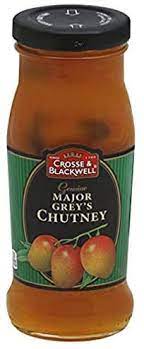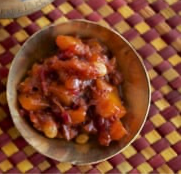Chutney - especially mango
- rosemary
- Oct 7, 2022
- 6 min read
"What the British did was just simplify and standardise what seemed like a general Indian trend." Madhur Jaffrey

This is Delia's version of Mango chutney. Delia is very British. In some ways I can't think of anyone more British on the cooking scene. British in herself that is, because she is very multicultural in the food that she cooks. Her influences come from everywhere. So you might think that this is her being influenced by the Indians.
But not really. Really she is being very old-fashioned British - the British in Imperial India, who sort of got the wrong idea about what chutney was, and thus invented something sort of new.
The Indians do make chutneys, but mostly not what we think of as chutney. The vast majority of their chutneys are made fresh and eaten on the day they were prepared:
"What was made fresh every day was a green chutney (usually with mint, fresh coriander and green chillies) and a salad with onions and tomatoes. According to the season, there were freshly-cut cucumbers, kohlrabi, radishes, carrots and spring onions on the table as well. There was always yoghurt, either natural or made into a raita with roasted cumin as its main flavour." Madhur Jaffrey
I'm sure you have all had this sort of chutney when you go to an Indian restaurant.

It's a mint/coriander chutney. It is usually put before you together with perhaps a tamarind chutney and some pappadams whilst you peruse the menu. A kind of dip I suppose, or even a pesto. They're delicious - a little bit spicy and fresh, fresh, fresh.
The Indians, according to Madhur Jaffrey in her Ultimate Curry Bible, do not generally make what we have come to think of as chutney - a fruit cooked with spices, and vinegar and onions to a jammy consistency that will keep for months. They do however make a huge variety of pickles - not only regional varieties but also pickles that are specific to one household. Pickles are similar to chutneys and I guess sometimes the lines between them blur. But they are different. Pickles are not usually fruity, and not usually cooked with sugar. Indeed not cooked as much either.
In fact chutney - or a similar thing - dates back to at least the Romans, and they were not cooked either back then - but were also not like the fresh herby chutneys of today. More or less the same kind of ingredients as feature in what we know as chutneys were just mixed together put in bottles, corked and then left in the sun to mature. Mature? You would think they would go off, but then I guess the vinegar or other acid and the sugar would have prevented this. It's still done this way in some parts of India.
The name chutney, by the way comes from the hindi 'chatni' which means to lick or to eat with appetite. And the British do.
The most famous of the Anglo-Indian mango chutneys is the Major Grey version. Who was Major Grey you may ask? Well virtually no-one thinks that the origin story here is real. Which is interesting in itself because where there is smoke there is usually fire - even it's just a few sparks. In this case the story goes that Major Grey who was serving in India in the Bengal Lancers in the early nineteenth century, so liked the Indian chutneys that he invented this one - some say he told his cook to invent it to his requirements. He then brought it back to England where it was a hit. So popular in fact that Crosse and Blackwell copied the recipe and the rest is history. Below is a gallery of various versions which are more or less 'authentic' if that is a word that can be ascribed to this particular treat.
Whilst I was looking for these pictures - of, I have to say on the whole, fairly jelly-like consistency chutneys - I was horrified to discover that the price of a Major Grey labelled mango chutney today - even from brands like Sharwood's seems to be horrific - at least $50.00 and sometimes more. Why?
Back to that seemingly apocryphal story though. I guess the spark at the base of the story is that yes indeed some English army type or his wife or even a bureaucrat sort of invented it because:.

"just as Indians, like my mother, were led to believe that it was not possible to have an English meal without a soup, for the the British, a curry without rice and a chutney was a non-starter. The chutneys they seem to have focused on were of the sweet, sour and hot, preserve variety - rather like their own mint jellies and jams, only hot." Madhur Jaffrey
Which seems to me to be a very logical explanation.
Why is it apocryphal though? A personal name and the specific mention of the Bengal Lancers surely means something. Or maybe that's why it is indeed apocryphal. Researchers have probably researched and found there was no such man. So a clever marketing ploy on the part of the Sun Brand I suppose. Sun Brand seem to be the first producers - and there are other mango chutneys with similar names too - Bengal Club, Colonel Skinner's ... So marketing - even back then.
As I said, those various jars seem to be pretty jelly-like rather than what I image a chutney to look like - more like Delia's at the top of the page. And, there are lots of other non Major Grey jars of mango chutney on offer. Plus, being blessed with mangoes in this country, you can, of course, make your own. Saveur even has a recipe that they call Major Grey's chutney as do the people from the World Food Café in England. Or you can go popular and try Jamie's Mango chutney or even one from Coles. And they all look a lot more appetising than the stuff in the jars.
I was going to say that actually mango chutney should really be made with green unripe mangoes which are actually pretty difficult to find, but just about all of the recipes above - and all the others that I saw, use just ripe mangoes. Some didn't even specify just ripe. But then I realised that this is really why it is not really very Indian. As Madhur Jaffrey says the British liked the sweetness of their cooked chutneys so why would you use an unripe mango?
The green mango chutney that you will find in 'authentic' Indian recipe books is one of those fresh chutneys. None of my Indian cookbooks has a recipe for the Anglo-Indian type. Below is Christine Manfield's truly 'authentic' version of a green mango chutney.


The recipe is not online but it's just a blended mix of green mangoes, mint, coriander, chillies, lime juice, salt, caster sugar and ground cumin. A recipe that Ottolenghi sort of deconstructs in his mango salsa. The only things missing are the cumin and the chillies - but you could add them too if you wanted. Same ingredients, totally different look and also a totally different taste experience I'm willing to bet, mostly because of the completely different texture.

Chutney is now an absolute must in any British person's pantry. We may have even had some in our pantry back in my youth. It's a must component in a Ploughman's lunch, it's common in sandwiches, besides cheese and pickled onions for a snack, put on pies and sausages, taken on picnics and probably added to stews and soups. Every British cookbook and every British cook will have a chutney recipe somewhere in the repertoire. And frequently it's mango - still the very favourite, although closely followed by tomato.

And they are such fun to make. Once you have made two or three from recipes, you can go for it. If you have a glut of any kind of fruit - even watermelon rind as Epicurious suggests, you can have a go at inventing your own. All you need is your fruit then add spices, vinegar of some kind - and oh how many of them there are to choose from these days - sugar, maybe some onions or garlic or some such and some kind of dried fruit. Throw it all in a pot, cook until thick and syrupy and voilà a delicious chutney with which to impress your friends. Much easier than quince paste.
Britain and India. A sort of marriage made in heaven, albeit a stormy one with much abuse along the way. Certainly from a food point of view the years of British occupation in the sub-continent have been so productive - and so invigorating - for the British anyway.



















Comments